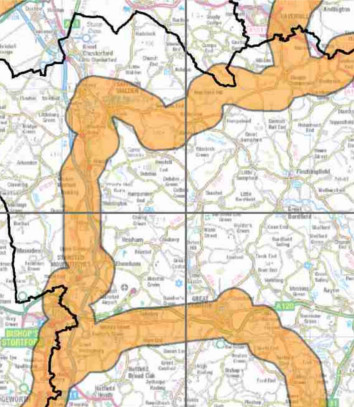B-Lines is a new project from the wildlife charity, Buglife.
Our bees, butterflies and hoverflies have suffered badly over the last fifty or so years, due to changes in land use like intensive farming, urban spread and new transport links.
Over 97% (an area the size of Wales) of all flower-rich grasslands have been lost in Britain since the 1930s, reducing pollen and nectar sources and leading to a serious decline in the wildlife depending on wildflower-rich habitat. B-Lines has the vision to help our native insect pollinators
The Government’s National Pollinator Strategy 2014 sets out a 10 year plan to help pollinating insects survive and thrive across England. The Strategy outlines actions to support and protect the many pollinating insects which contribute to our food production and the diversity of our environment. It looks to everyone to work together to help our pollinators.
What are B-Lines?
B-Lines are an imaginative and beautiful solution to the problem of the loss of flowers and pollinators. The B-Lines are a series of ‘insect pathways’, 3 kilometers wide, along which the aim is to restore and create a series of wildflower-rich habitat stepping stones. They link existing wildlife areas together, creating a network, like a railway, that will weave across the British landscape. This will provide large areas of brand new habitat benefiting bees and butterflies– but also a host of other wildlife. The B-Line for Essex can be found as part of the East of England B-Lines project at https://buglife.org.uk/campaigns-and-our-work/habitat-projects/b-lines/east-of-england-b-lines . In Uttlesford District the corridor passes through Hempstead, Radwinter, Saffron Walden, then turns south to Stansted, The Hallingburys, then eastwards along the Flitch Way to Great Dunmow and on through Felstead and towards Chelmsford.
The Benefits of B-Lines
B-Lines bring a range of benefits to wildlife, people and agriculture.
These include:
- Helping conserve our native pollinators and a range of other wildlife and contributing towards the 2020 Biodiversity targets
- Helping our wildlife respond to climate change by making it easier for them to move around
- Increasing the number of insect pollinators and the benefits these bring to our farming sector (pollination being an important ‘ecosystem service’)
- Bringing nature to people
- Giving opportunities for everyone to play their part and help create the B-Lines network
Making B-Lines
B-Lines aims to create and restore at least 150,000 hectares of flower-rich habitat across the UK. Making this happen will take time and will need farmers, land owners, wildlife organisations, businesses, local authorities and the general public to work together to create flower-rich grassland in the best locations.
Everyone can take part! Whether you own a large area of land that you would like to turn into a wildflower meadow or just have a window sill or small patio, you can help to create the B-Lines network. Whether you’re a landowner, farmer, school, local authority, business or an individual hoping to make a difference you can help create wildflower habitat in your area. – See more at:< https://www.buglife.org.uk/campaigns-and-our-work/habitat-projects/take-part-creating-our-b-lines >, where a range of advice and help sheets can be found to download.
You can see how the B-Lines are developing on an interactive map https://www.buglife.org.uk/campaigns-and-our-work/habitat-projects/helping-create-b-lines . Please add your information so we can see how the B-lines are growing.
– See more at: https://buglife.org.uk/campaigns-and-our-work/habitat-projects/b-lines

